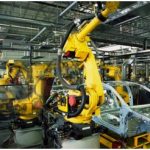 Industrial robots have been around for about 50 years.
Industrial robots have been around for about 50 years.
In fact, the very first industrial robot was used by General Motors for material handling.
Today, businesses can’t function efficiently without at least some form of robotic intervention in daily industrial or manufacturing operations.
An Industrial Robot Is the Lifeblood for Many Businesses and Their Applications
By industrial robot, we refer to a robot arm that’s commonly used in a factory environment. Primarily used for manufacturing applications, there’re numerous other applications for which industrial robots can be used for, even if used.
The automotive industry, along with food & beverage, rely on industrial robots for assembling, packaging and loading different products.
A different criterion is used to classify traditional industrial robots, such as;
- Type of Movement
- Application
- Architecture
- Brand
There’s a new qualifier for differentiating and choosing industrial robots, i.e. robots that are collaborative or not. All of the above should be considered when choosing an industrial robot to bring efficiency to your business’s manufacturing process.
The Common Types of Industrial Robots in Use Today
 The application you aim to use the robot for will be considered before anything else. This isn’t to say one type of robot won’t work for another application as this machinery can be upgraded, i.e. industrial robot mechanical parts can be assembled to increase the applications the robot can perform.
The application you aim to use the robot for will be considered before anything else. This isn’t to say one type of robot won’t work for another application as this machinery can be upgraded, i.e. industrial robot mechanical parts can be assembled to increase the applications the robot can perform.
The different types of industrial robots are as follows;
Articulated
This particular robot design showcases rotary joints, ranging from the simple 2 joint structures (to 10) or more joints.
The arm, the most important part of any industrial robot, is attached to the base, and paired with a twisted joint.
Rotary joints are how the links are connected in the arm.
One benefit of articulated type industrial robots is the additional range of motion that’s possible through each joint.
These robots are used for their flexibility and dexterity when it comes to conducting operations.
Cartesian
Also known as gantry or rectilinear robots, this type features three linear joints that operate with the help of the Cartesian coordinate system.
This type of industrial robot can also feature an attached wrist meant for rotational movement of the arm.
Linear motion is being followed (along the axis) with help from three prismatic joints in a Cartesian industrial robot. This type of industrial robot is used for sealing, as a transfer and stacking device, as a conveyor and other applications.
Cylindrical
Attached at the base with one rotary joint and at least one prismatic, cylindrical robots operate within a cylindrical shaped space. This is because the rotary joints uses the rotational motion while prismatic operates in a linear motion.
Polar
This type of robot is also known as spherical robots. The configuration of polar industrial robots is; the arm is linked to the base with the help of a twisting joint and combination of rotary (2) and linear (1) joints. The name of the industrial robot is derived from the range of motion, i.e. polar coordinate system.
Used in the manufacturing industry because of obvious reasons (lowered productivity costs, increased efficiency, minimized errors), you too can avail industrial robots and bring your business operations high up! Contact UsedRobotsTrade and avail from our special offers today.
